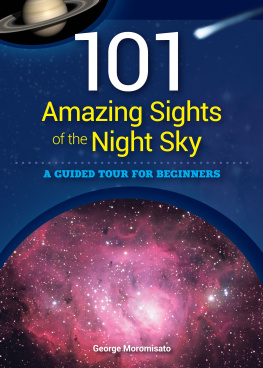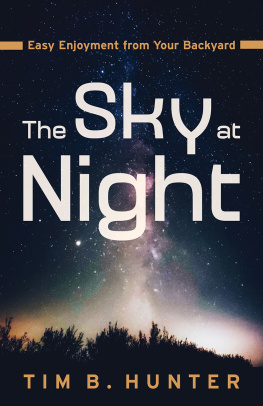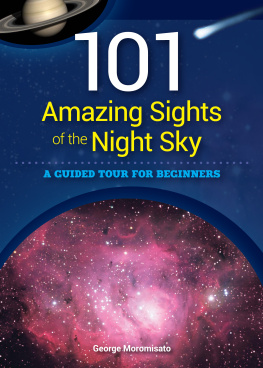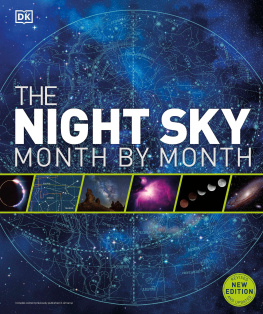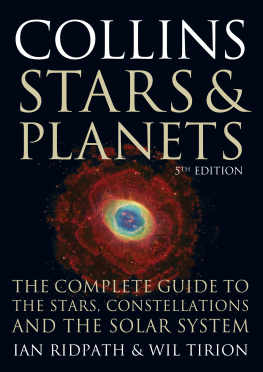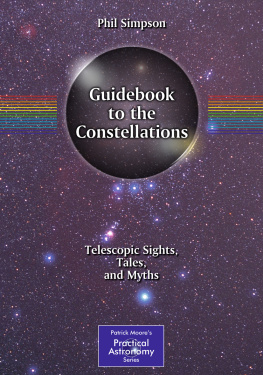

DEDICATION
To Jorge and Celinda, for helping me see the sky.
ACKNOWLEDGMENTS
When I was in high school, my friends and I watched Carl Sagans Cosmos series. We loved to make fun of his billions and billions, but we were also thoroughly entranced. Astronomy, even via broadcast TV, is best shared, and I thank my friends for the experience. I thank my many teachers, formal and otherwise, who patiently transmitted knowledge while kindling my imagination. Not least, I thank my beautiful wife with whom I can share this and so many other things.
Cover and book design by Jonathan Norberg
Edited by Brett Ortler
Photo credits:
Atlas Image obtained as part of the Two Micron All Sky Survey (2MASS), a joint project of the University of Massachusetts and the Infrared Processing and Analysis Center/California Institute of Technology, funded by the National Aeronautics and Space Administration and the National Science Foundation
The following (unaltered) image is licensed according to a Creative Commons Attribution 3.0 License (.
Ceres image courtesy of Justin Cowart; original available here: http://planetary.s3.amazonaws.com/assets/images/9-small-bodies/2015/20151022_ceres_rc3_haulani_cowart.png; additional citation: NASA / JPL-Caltech / UCLA / MPS / DLR / IDA
The following images are licensed via Shutterstock: ,
10 9 8 7 6 5 4 3 2 1
Copyright 2017 by George Moromisato
Published by Adventure Publications
An imprint of AdventureKEEN
820 Cleveland Street South
Cambridge, Minnesota 55008
(800) 678-7006
www.adventurepublications.net
All rights reserved
Printed in U.S.A.
ISBN: 978-1-59193-557-5; eISBN: 978-1-59193-684-8
TABLE OF CONTENTS
INTRODUCTION
Once, we were all astronomers. Before electric lights banished the Milky Way, and before digital clocks announced the time, and way before GPS satellites let us know exactly where we are on Earth, the night sky was our entertainment, our timepiece, and our compass.
Understanding the night sky was a matter of life or death. The North Star guided wandering hunters back home, and the rising of the constellations determined when planting should start or when the Nile might flood. But above all, the glowing shapes and patterns of the sky evoked the deepest questions: Whats out there? What does it all mean? Are we alone in the universe?
Today, thousands of years later, weve gained knowledge our ancestors could never imagine. Weve worked out the motion of the stars and planets; weve unraveled the nature of the starry sky without ever visiting it; and weve probed back in time to study the creation of the universe itself! Yet when I look up into the sky, far vaster and more ancient than anyone could have imagined, Im faced with the same questions: Whats out there? What does it all mean? Are we alone in the universe?
Ultimately, astronomy isnt about the stars; its about us. We are awed by the scale of the universe, thrilled by the beauty of colliding galaxies, and humbled by the work and dedication that went into discovering it all. We dont need to be astronomers anymore, but we want to be.
ABOUT THIS BOOK
I wrote this book to share my love of astronomy. Ive been an amateur astronomer ever since my parents bought me my first telescopea mail-order 4-inch Astroscanand I hope to convey just a little bit of the joy I feel when Im under the stars. This is not a scholarly work, or an exhaustive reference guide; it isnt even a proper beginners guide. Instead, think of this book as a greatest hits collection. Ive compiled a list of the 101 most beautiful, most important, and most fascinating sights in astronomy, and the goal of this book is to take you on a guided tour of them all.
To create the list, I started with several hundred astronomical sights from various catalogs. I excluded any Southern Hemisphere objects that are invisible from North America, and any faint objects that are beyond the reach of the average backyard telescope.
Next, I rated each one based on three criteria: beauty, significance, and accessibility. Beauty rates the visual appeal of the object from 1 to 5, with 5 being the best. A solar eclipse rates a 5, while an anonymous faint star rates a 1. Significance rates the scientific, historic, or cultural importance of the object. Saturn, for example, is highly significantit is one of the few astronomical objects that an average person could describe. Accessibility rates how easy it is to see. The moon, for example, is relatively easy to see.
I then combined the three ratings into a single number, weighing beauty the most and accessibility the least. The result was a rating for each sight, allowing me to order them into a Top 101 list.
Of course, this list is entirely subjective. Different people will have wildly different ideas about what should go in a Top 101 list, and I certainly dont claim that my list is better than anyone elses. But even if you disagree with my selections, I hope this book will inspire you to get out there, observe the night sky, and maybe even create your own list.
OBSERVING THE NIGHT SKY
Many years ago I took a bird-watching tour in the Peruvian Amazon. We hiked through the rainforest at dawn, while our guide spotted birds. All I could see was trees, but he could always find a colorful parakeet or macaw hidden in the lush green canopy. Look there! Just below that crooked branch, he would say. Once he pointed it out, it was obvious. But without him, we would have seen nothing.
I asked him how he did it. Was his eyesight unusually sharp? No, he said, it was just experience. After spending years in the rainforest, he could guess where birds were likely to be. He taught me a few tricks, such as always looking at the tallest tree around because birds like to perch there. A few simple guidelines allowed me to see the invisible.

THE MILKY WAY
Observing the many beautiful objects of the night sky is both easier and harder than bird-watching. On the one hand, most sights follow a predictable pattern: the Orion Nebula is always in the sky in winter (at least in the Northern Hemisphere). On the other hand, seeing detail in a faint patch of light will challenge your skills even if you know where to look.
Only experiencehundreds of nights spent under the starswill turn you into an expert. And while this book is not designed to be a complete field guide, I hope to give you a few tricks to get you started.
THE MOTION OF THE STARS
If you could stand perfectly still out in space, the stars would not move at allnot in less than a human lifespan, anyway. But of course, were not standing still. Were standing on a planet that spins on its axis once a day and orbits around its sun once a year. Were constantly moving, and therefore the stars appear to move.
Imagine that youre standing on a spinning carousel, looking up at a sky dotted with clouds. As you spin around, you might notice that all the clouds seem to be spinning around a single cloud in the center of your view. Theres nothing special about that cloud: it just happens to be directly above the carousels spinning axis.
Next page
